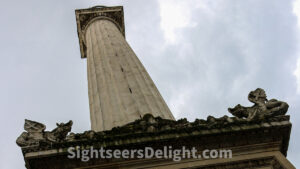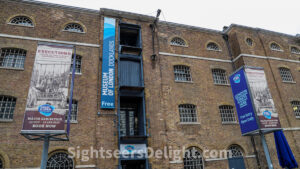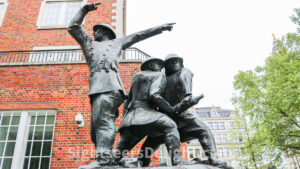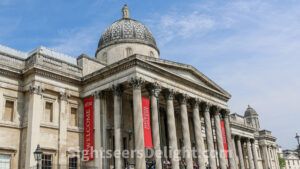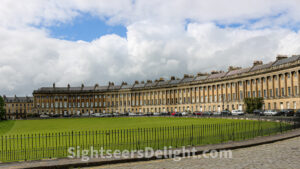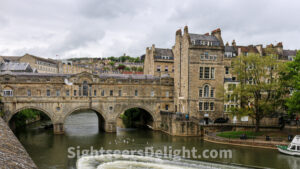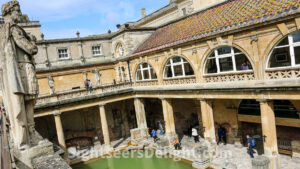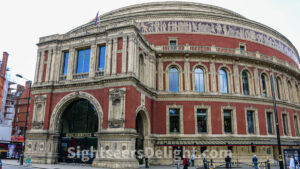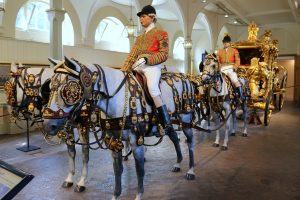The Monument to the Great Fire of London commemorates the Great Fire of London, which started on Sept. 2, 1666. The Monument, as it is colloquially known, was built between 1671 and 1677 on the site of St. Margaret’s, the first church the Great Fire destroyed, and 202 feet west of where the Great Fire started. The Monument is a fluted Doric column built of Portland stone. It is 202 feet tall and topped with a gilded urn of fire.
The Museum of London Docklands in West India Quay tells the ever-changing story of London from 450,000 BC to the present day. The galleries, exhibitions, displays, and activities aim to ignite enthusiasm for London and showcase the city’s vibrant and distinctive character. The museum explains the River Thames’ history, the Port of London’s growth, and the docks’ historical link to the Atlantic slave trade. It opened in 2003 and is housed in a Grade I listed early-19th century Georgian “low” sugar warehouse built in 1802 on the north side of West India Docks, just a short walk from Canary Wharf.
The National Firefighters Memorial of three bronze statues showing firefighters in action is a tribute to the brave men and women who fought fires during the Blitz in London. The memorial, located on the Jubilee Walkway near St. Paul’s Cathedral, was created to honor the firefighters who fought fires on the streets of London during World War II and to commemorate the service of firefighters throughout the war. Cyril Demarne conceived the idea for the memorial, which was commissioned by the Firefighters Memorial Charitable Trust in 1990. Sculpted by John W. Mills, the monument was unveiled by Queen Elizabeth The Queen Mother on May 4, 1991. In 1998, it was decided to make the memorial a national monument to honor all firefighters in the United Kingdom who lost their lives while on duty, not just during World War II. As a result, the monument was moved from its original location in Old Change Court, the plinth was raised by more than one meter, and the names of all firefighters who died in peacetime were added.
The National Gallery dates to 1824 when the British government bought 38 paintings from the heirs of John Julius Angerstein, a London businessman. Today, the museum, located in Trafalgar Square, is home to more than 2,300 works of art, some dating to the mid-13th century. Some critics point out the museum’s collection is smaller when compared to other European national galleries.
A famous semicircle row of Georgian townhouses was built based on designs by architect John Wood the Younger between 1767 and 1774. One of the houses, the No. 1 Royal Crescent, has been preserved as a museum, giving visitors a window into 18th century life. Complete with authentic furniture and artifacts, each room tells a story of daily life 300 years ago. In one of the rooms, the Gentlemen’s Retreat, visitors can learn more about Henry Sandford, the townhouse’s first resident who lived here from 1776 until 1796.
Old Sarum is an abandoned hill fort dating that was likely established in 400 BC. The Romans later used the site and created the town of Sorviodunum. A trio of Roman roads converged near the site, making it an essential strategic location. Following the Norman conquest of England in 1066, the city was expanded, but it was largely abandoned in the 13th century. The bishop of Salisbury, Osmund de Sees, completed a small cathedral at the site in 1092. Little is left of the city, as much of the original construction in Old Sarum was demolished after Henry VIII sold the rights to the castle’s remains in 1514.
The Pulteney Bridge is a historic bridge in Bath, England, spanning the River Avon. It was constructed in 1774 to link the city with the Pulteney family’s land, which they wanted to develop. Robert Adam designed the bridge, which features a unique Palladian style with shops built on both sides. It has been classified as a Grade I listed building. Within two decades of its completion, the shops were expanded, and the façades were altered. Floods damaged the bridge by the end of the 18th century, but it was rebuilt with a similar design. In the following century, renovations were made to the shops, including cantilevered extensions on the bridge’s north face. Later in the 20th century, preservation efforts were carried out to restore the bridge’s original appearance, making it more attractive as a tourist destination.
The Roman Baths, for which this southwestern England city is named, are some of the most remarkable Roman ruins outside of Rome itself. The area’s natural hot springs were used long before the Romans under Emperor Claudius invaded Britain, starting in 43 AD. Archaeological evidence shows human activity around the springs dating to 8,000 BC, though the area may have been too hot and swampy for a permanent settlement. Today, the Roman ruins stand at the center of this historic city. Much like their counterparts in Rome itself, the bath ruins provide a marvelous insight into both the magnificence of the buildings constructed by the Romans and daily life during Roman times.
The Royal Albert Hall is a renowned concert hall in northern South Kensington, London. It is considered one of the UK’s most precious and recognizable buildings. The hall is managed by a registered charity that doesn’t receive government funding and is held in trust for the nation. It has a seating capacity of 5,272 people.
The Royal Mews is the home of the stables, carriage house and garage of the British Royal Family. The Royal Mews is in the grounds of Buckingham Palace, to the south of Buckingham Palace Gardens, near Grosvenor Place. George III moved some of his day-to-day horses and carriages to the grounds of Buckingham House in the 1760s.

